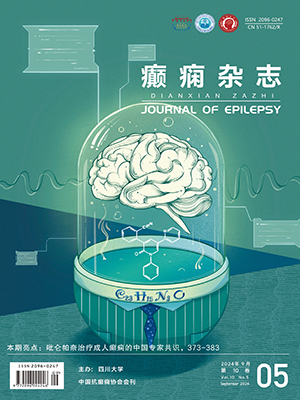| 1. |
Sillanpää M, Lastunen S, Helenius H, et al. Regional differences and secular trends in the incidence of epilepsy in Finland: a nationwide 23-year registry study. Epilepsia, 2011, 52 (10): 1857-1867.
|
| 2. |
Donner EJ, Camfield P, Brooks L, et al. Understanding death in children with epilepsy. Pediatr Neurol, 2017, 70: 7-15.
|
| 3. |
Gerald B, Ramsey K, Belnap N, et al. Neonatal epileptic encephalopathy caused by de novo GNAO1 mutation misdiagnosed as atypical Rett syndrome: Cautions in interpretation of genomic test results. Semin Pediatr Neurol, 2017. [Available online].
|
| 4. |
Thomas RH, Berkovic SF. The hidden genetics of epilepsyaclinically important new paradigm. Nat Rev Neurol, 2014, 10(5): 283-292.
|
| 5. |
Martin HC, Kim GE, Pagnamenta AT, et al. Clinical whole-genome sequencing in severe early- onset epilepsy reveals newgenes and improves molecular diagnosis. Hum Mol Genet, 2014, 23(12): 3200-3211.
|
| 6. |
Milh M, Cacciaqli P, Ravix C et al. Severe neonatal seizures: From molecular diagnosis to precision therapy?. Rev Neurol(Paris), 2016, 172(3): 171-173.
|
| 7. |
Gerber SH, Rah JC, Min SW, et al. Conformational switch of syntaxin-1 controls synaptic vesiclefusion. Science, 2008, 321: 1507-1510.
|
| 8. |
Milh M, Villeneuve N, Chouchane M, et al. Epileptic and nonepileptic features in patients with early onset epileptic encephalopathy and STXBP1 mutations. Epilepsia, 2011, 52(10): 1828-1834.
|
| 9. |
Saitsu H, Kato M, Mizuguchi T, et al. De novo mutations in the gene encoding STXBP1 (MUNC18-1) cause early infantile epileptic encephalopathy. Nat Genet, 2008, 40(6): 782-788.
|
| 10. |
Saitsu H, Kato M, Okada I, et al. STXBP1 mutations in early infantile epileptic encephalopathy with suppression-burst pattern. Epilepsia, 2010, 51(12): 2397-2405.
|
| 11. |
Deprez L, Weckhuysen S, Holmgren P et al. Clinical spectrum of early-onset epileptic encephalopathies associated with STXBP1 mutations. Neurology, 2010, 75(13): 1159-1165.
|
| 12. |
Bahi-Buisson N, Nectoux J, Rosas-Vargas H, et al. Key clinical features to identify girls with CDKL5 mutations. Brain, 2008, 131(Pt 10): 2647-2661.
|
| 13. |
Nemos C, Lambert L, Giuliano F, et al. Mutational spectrum of CDKL5 in early-onset encephalopathies: a study of a large collection of french patients and review of the literature. ClinGenet, 2009, 76(4): 357-371.
|
| 14. |
Melani F, Mei D, Pisano T, et al. CDKL5 gene-related epileptic encephalopathy: electroclinical findings in the first year of life. DevMedChild Neurol, 2011, 53(4): 354-360.
|
| 15. |
Liang JS, Shimojima K, Takayama R, et al. CDKL5 alterations lead to early epileptic encephalopathy in both genders. Epilepsia, 2011, 52 (10): 1835-1842.
|
| 16. |
Campbell IM, Yatsenko SA, Hixson P, et al. Novel 9q34.11 gene deletions encompassing combinations of four Mendelian disease genes: STXBP1, SPTAN1, ENG, and TOR1A. GenetMed, 2012, 14(10): 868-876.
|
| 17. |
Saitsu H, Tohyama J, Kumada T, et al. Dominant-negative mutations in alpha-II spectrin cause West syndrome with severe cerebral hypomyelination, spastic quadriplegia, and developmental delay. Am J Hum Genet, 2010, 86: 881-891.
|
| 18. |
Okazaki S, Ohsawa M, Kuki I, et al. Aristaless-related homeobox gene disruption leads to abnormal distribution of GABAergic interneurons in human neocortex: evidence based on a case of x-linked lissencephaly with abnormal genitalia (XLAG). Acta Neuropathol, 2008, 116 (4): 453-462.
|
| 19. |
Pavone P, Spalice A, Polizzi A, et al. Ohtahara syndrome with emphasis on recent genetic discovery. Brain Dev, 2012, 34(6): 459-468.
|
| 20. |
Depienne C, Bouteiller D, Keren B, et al. Sporadic infantile epileptic encephalopathy caused by mutations in PCDH19 resembles dravet syndrome but mainly affects females. PLoS Genet, 2009, 5(2): e1000381.
|
| 21. |
Weckhuysen S, Mandelstam S, Suls A, et al. KCNQ2 encephalopathy: Emerging phenotype of a neonatal epileptic encephalopathy. Ann Neurol, 2012, 71 (1): 15-25.
|
| 22. |
Harkin LA, McMahon JM, Iona X, et al. The spectrum of SCN1A-related infantile epileptic encephalopathies. Brain, 2007, 130(Pt 3): 843-852.
|
| 23. |
Usluer S, Salar S, Arslan M, et al. SCN1A gene sequencing in 46 Turkish epilepsy patients disclosed 12 novel mutations. Seizure, 2016, 39: 34-43.
|
| 24. |
田小娟, 张月华, 杨小玲, 等. 547 例 Dravet 综合征患儿 SCN1A 基因突变与遗传特点研究. 癫痫杂志, 2016, 2(1): 3-8.
|
| 25. |
Mefford HC, Yendle SC, Hsu C, et al. Rare copy number variants are an important cause of epileptic encephalopathies. Ann Neurol, 2011, 70 (6): 974-985.
|
| 26. |
Joshi C, Kolbe DL, Mansilla MA, et al. Reducing the cost of the diagnostic odyssey in early onset epileptic encephalopathies. Biomed Res, 2016, 2016: 6421039.
|
| 27. |
Kim YO, Yang JH, Park C, et al. A novel PIGA mutation in a family with X-linked, early-onset epileptic encephalopathy. Brain Dev. 2016, 38 (8): 750-754.
|




